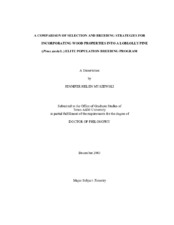| dc.contributor.advisor | Bridgwater, Floyd | |
| dc.creator | Myszewski, Jennifer Helen | |
| dc.date.accessioned | 2004-09-30T01:41:35Z | |
| dc.date.available | 2004-09-30T01:41:35Z | |
| dc.date.created | 2003-12 | |
| dc.date.issued | 2004-09-30 | |
| dc.identifier.uri | https://hdl.handle.net/1969.1/75 | |
| dc.description.abstract | The heritability of microfibril angle (MFA) in loblolly pine, Pinus taeda L., and its genetic relationships with height, diameter, volume and specific gravity were examined in two progeny tests with known pedigrees. Significant general combining ability (GCA), specific combining ability (SCA), and SCA x block effects indicated that there are both additive and non-additive genetic influences on MFA. Individual-tree narrow-sense heritability estimates were variable, ranging from 0.17 for earlywood (ring) 4 MFA to 0.51 for earlywood (ring) 20 MFA. Genetic correlations between MFA, specific gravity and the growth traits were non-significant due to large estimated standard errors.
Multiple-trait selection and breeding in a mainline and elite population tree improvement program were simulated using Excel and Simetar (Richardson 2001). The effects of four selection indices were examined in the mainline population and the effects of seven selection indices and four breeding strategies were examined in the elite population. In the mainline population, selection for increased growth caused decreased wood quality over time. However, it was possible to maintain the overall population mean MFA and mean specific gravity at levels present in the base population by implementing restricted selection indices. Likewise, selection for improved wood quality in the elite population resulted in decreased growth unless restricted selection indices or pulp indices derived from those of Lowe et al. (1999) were used. Correlated phenotypic responses to selection on indices using economic weights and heritabilities were dependent on breeding strategy. When a circular mating system (with parents randomly assigned to controlled-crosses) was used, the index trait with a higher economic weight was more influential in determining correlated responses in non-index traits than the index trait with a lower economic weight. However, when positive assortative mating was used, the index trait with a greater variance was more influential in determining correlated responses in non-index traits than the index trait with a lower variance regardless of economic weight. | en |
| dc.format.extent | 669332 bytes | en |
| dc.format.extent | 194247 bytes | en |
| dc.format.medium | electronic | en |
| dc.format.mimetype | application/pdf | |
| dc.format.mimetype | text/plain | |
| dc.language.iso | en_US | |
| dc.publisher | Texas A&M University | |
| dc.subject | forest genetics | en |
| dc.subject | tree improvement | en |
| dc.subject | simulation | en |
| dc.subject | wood quality | en |
| dc.subject | microfibril angle | en |
| dc.subject | heritability | en |
| dc.title | A comparison of selection and breeding strategies for incorporating wood properties into a loblolly pine (Pinus taeda L.) elite population breeding program | en |
| dc.type | Thesis | en |
| thesis.degree.department | Forest Science | en |
| thesis.degree.discipline | Forestry | en |
| thesis.degree.grantor | Texas A&M University | en |
| thesis.degree.name | Doctor of Philosophy | en |
| thesis.degree.level | Doctoral | en |
| dc.contributor.committeeMember | Lowe, William | |
| dc.contributor.committeeMember | Byram, Thomas | |
| dc.contributor.committeeMember | Loopstra, Carol | |
| dc.contributor.committeeMember | Betran, Javier | |
| dc.contributor.committeeMember | Megraw, Robert | |
| dc.type.genre | Electronic Dissertation | en |
| dc.type.material | text | en |
| dc.format.digitalOrigin | born digital | en |


